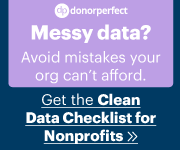- Home
- About Us
- The Team / Contact Us
- Books and Resources
- Privacy Policy
- Nonprofit Employer of Choice Award

Data cleanup actually has the potential to bring your fundraising team closer together - a healthier donor database means healthier workflows and work relationships. 
Each role in your organization has a different relationship with your fundraising data, so a smooth data entry process allows everyone to stay on the same page. Establishing proper data procedures also paves the way for effortless CRM maintenance, new-hire training, and reporting for better fundraising results overall.
Messy data is caused by errors of omission, duplication, transcription, and more. The data cleanup process saves your organization from issuing corrections, reversing payments, alienating donors, and dipping into funds meant for your mission. Otherwise, there’s no way to know what details are being omitted, duplicated, or transcribed incorrectly.
Three steps to starting the data cleanup process
STEP 1 - Create guidelines
Create a resource that outlines the proper data procedures for your CRM, including: donor records, contact records, thanking donors, and routine maintenance.
Considerations:
Donor record information
Gift entry
Gift follow-up
Tracking points of contact
Data integrity maintenance
Avoiding duplicates
Address cleanup
Donor record removal
Code maintenance
You will also want to consider details that may apply specifically to your organization or sector.
STEP 2 - Compare notes
We recommend having each member of your team who will be working in your CRM save their own copy of your procedure guide. Then, get everyone together to compare notes and identify discrepancies.
This approach avoids singling someone out or making an example out of anyone. Encourage healthy discourse about which data procedures will elicit the most accurate reports and improve the overall understanding of your donors.
STEP 3 - Try an exercise
Get your team in the collaborative spirit with a group exercise. Your Executive Director may be looking at your data from a completely different vantage point than a Development Director or volunteer. One team member might even have an impressive method that you all agree to put into practice. This approach lightens the mood and celebrates the strengths of each person, allowing your team to focus on its efficiency instead of any feelings of inadequacy.
Sample exercise: You host a gala where you encourage attendees to fill out pledge cards at their table placements. Some donors committed to pay their pledge monthly, with no end date specified, while others were specific about the dates of their payment schedule. Some donated by writing a check for the first month to show they would make good on their commitment, vowing to pay the rest electronically.
Your nonprofit data is meant to help your organization make more informed decisions that will ultimately lead to more revenue for your mission, not make your job harder than it needs to be. The work you’ve just completed is cause for celebration - you’ve saved countless hours and headaches in the future - for you, your teammates, and your future teammates!
For more resources like the Clean Data Checklist, visit us at donorperfect.com